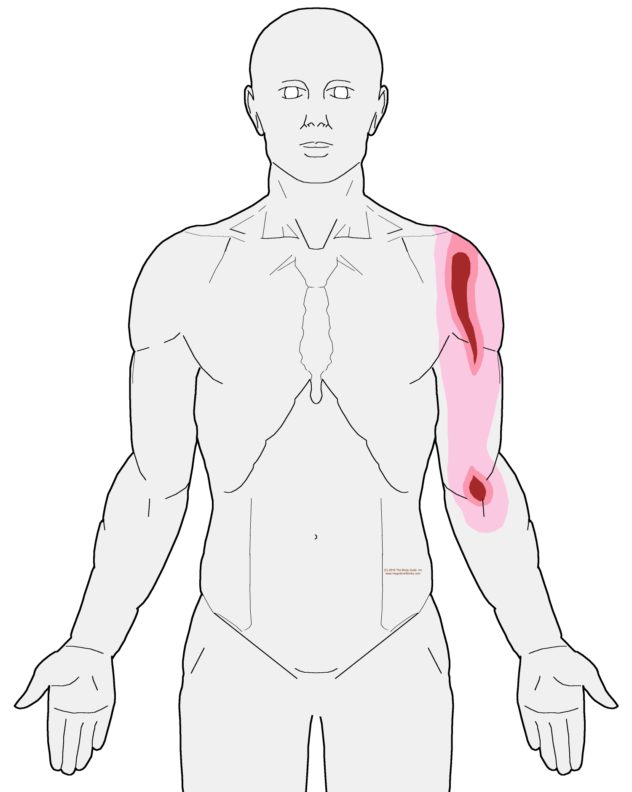Front of Elbow Pain When Carrying or Shoveling
Table of Contents
- How People Describe This Pain Pattern
- How You Activate and Intensify This Pain Pattern
- Self-Care – Getting Relief on Your Own
- Musculoskeletal Anatomy Behind Your Pain
- Therapy Notes for Massage and Bodywork
How People Describe This Pain Pattern


Pain While Carrying
Patients complain of this pain in the front of their elbow when picking up and carrying things. Heavier objects may produce sharper pain. Even moderately heavy objects can create an achy pain in the bicep with a sharper pain in the pocket of the elbow.
This elbow pain tends to be less bothersome when picking up objects with the palm facing down.
Shoulder Pain
When asked about the shoulder pain, the patient will sometimes say that it always bothers them, so they didn’t think to mention it. In other cases, they admit to the superficial strip of pain when I ask them to raise their arm and twist their wrist. I explore that pattern in this other post.
You might notice that the elbow on the arm with pain is almost always flexed when they stand. Straightening the arm will often result in complaints of trouble doing so.
How You Activate and Intensify This Pain Pattern
Repeated or Sudden Load
This elbow pain can also come from vigorous or repeated flexing of the elbow while twisting the wrist. A recent client came in with this problem after shoveling gravel into wheelbarrows. Clients have also complained of this after moving blocks while landscaping.
Pain in the front of the elbow can also occur from awkward and forceful flexing and twisting. One client had this after his cordless drill quit, and he tried driving in screws by hand.
Grabbing under a ledge to stop a fall, stopping a slamming car hood, or being handed a heavy child are all excellent ways to aggravate this trigger point. When activated in one of these ways, there is typically some binding in the elbow joints.
Jerking while Straining
Jerking or straining the elbow can also cause this pain. Holding the elbow flexed, such as you might when carrying trash bags or suitcases, may aggravate the trigger point.
Biceps also get strained when the elbow is straightened with force or a jerky motion. Triggers for this include a forceful backhand in tennis or getting the arm jerked when raising the tailgate on your SUV.
The Musculoskeletal Anatomy Behind Your Pain
Musculoskeletal Anatomy
This post on anatomy contains standard information about the origin, insertion, function, and innervation of muscles. Additionally, it includes information on functional considerations and anomalies.
Find Related Posts
Anatomy posts have a grid of all related posts. This includes posts on pain patterns, self-care, therapy notes, NMT protocols, cranial techniques, and cases.
Getting Relief on Your Own
Clinically Proven
Self-Care Strategies
Self-Care Posts have common sections to make them easy to follow and understand:
- Activities to Avoid or Change
- Strategies for Quick Relief
- Stretches and Exercise for Longer-Lasting Relief
- Yoga Corner
Therapy Notes for Massage and Bodywork
Better Bodywork
Through Shared Expertise
Therapy Notes provide details for cranial, spinal, and local joint work. These notes also link to a traditional neuromuscular protocol.
By treating integrative components first, direct work on the muscle becomes less intense while providing longer-lasting relief.
Support Integrative Works to
stay independent
and produce great content.
You can subscribe to our community on Patreon. You will get links to free content and access to exclusive content not seen on this site. In addition, we will be posting anatomy illustrations, treatment notes, and sections from our manuals not found on this site. Thank you so much for being so supportive.
Cranio Cradle Cup
This mug has classic, colorful illustrations of the craniosacral system and vault hold #3. It makes a great gift and conversation piece.
Tony Preston has a practice in Atlanta, Georgia, where he sees clients. He has written materials and instructed classes since the mid-90s. This includes anatomy, trigger points, cranial, and neuromuscular.
Question? Comment? Typo?
integrativeworks@gmail.com
Follow us on Instagram
*This site is undergoing significant changes. We are reformatting and expanding the posts to make them easier to read. The result will also be more accessible and include more patterns with better self-care. Meanwhile, there may be formatting, content presentation, and readability inconsistencies. Until we get older posts updated, please excuse our mess.